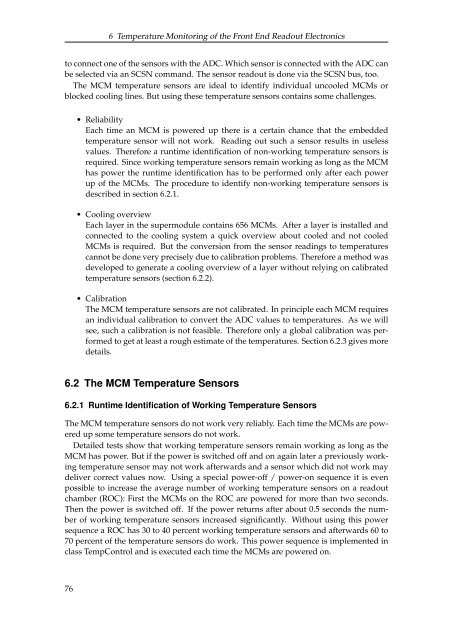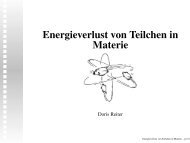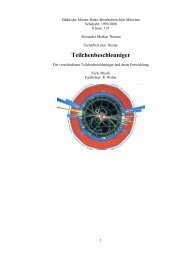The FEE Server Control Engine of the ALICE-TRD - Westfälische ...
The FEE Server Control Engine of the ALICE-TRD - Westfälische ...
The FEE Server Control Engine of the ALICE-TRD - Westfälische ...
You also want an ePaper? Increase the reach of your titles
YUMPU automatically turns print PDFs into web optimized ePapers that Google loves.
6 Temperature Monitoring <strong>of</strong> <strong>the</strong> Front End Readout Electronics<br />
to connect one <strong>of</strong> <strong>the</strong> sensors with <strong>the</strong> ADC. Which sensor is connected with <strong>the</strong> ADC can<br />
be selected via an SCSN command. <strong>The</strong> sensor readout is done via <strong>the</strong> SCSN bus, too.<br />
<strong>The</strong> MCM temperature sensors are ideal to identify individual uncooled MCMs or<br />
blocked cooling lines. But using <strong>the</strong>se temperature sensors contains some challenges.<br />
• Reliability<br />
Each time an MCM is powered up <strong>the</strong>re is a certain chance that <strong>the</strong> embedded<br />
temperature sensor will not work. Reading out such a sensor results in useless<br />
values. <strong>The</strong>refore a runtime identification <strong>of</strong> non-working temperature sensors is<br />
required. Since working temperature sensors remain working as long as <strong>the</strong> MCM<br />
has power <strong>the</strong> runtime identification has to be performed only after each power<br />
up <strong>of</strong> <strong>the</strong> MCMs. <strong>The</strong> procedure to identify non-working temperature sensors is<br />
described in section 6.2.1.<br />
• Cooling overview<br />
Each layer in <strong>the</strong> supermodule contains 656 MCMs. After a layer is installed and<br />
connected to <strong>the</strong> cooling system a quick overview about cooled and not cooled<br />
MCMs is required. But <strong>the</strong> conversion from <strong>the</strong> sensor readings to temperatures<br />
cannot be done very precisely due to calibration problems. <strong>The</strong>refore a method was<br />
developed to generate a cooling overview <strong>of</strong> a layer without relying on calibrated<br />
temperature sensors (section 6.2.2).<br />
• Calibration<br />
<strong>The</strong> MCM temperature sensors are not calibrated. In principle each MCM requires<br />
an individual calibration to convert <strong>the</strong> ADC values to temperatures. As we will<br />
see, such a calibration is not feasible. <strong>The</strong>refore only a global calibration was performed<br />
to get at least a rough estimate <strong>of</strong> <strong>the</strong> temperatures. Section 6.2.3 gives more<br />
details.<br />
6.2 <strong>The</strong> MCM Temperature Sensors<br />
6.2.1 Runtime Identification <strong>of</strong> Working Temperature Sensors<br />
<strong>The</strong> MCM temperature sensors do not work very reliably. Each time <strong>the</strong> MCMs are powered<br />
up some temperature sensors do not work.<br />
Detailed tests show that working temperature sensors remain working as long as <strong>the</strong><br />
MCM has power. But if <strong>the</strong> power is switched <strong>of</strong>f and on again later a previously working<br />
temperature sensor may not work afterwards and a sensor which did not work may<br />
deliver correct values now. Using a special power-<strong>of</strong>f / power-on sequence it is even<br />
possible to increase <strong>the</strong> average number <strong>of</strong> working temperature sensors on a readout<br />
chamber (ROC): First <strong>the</strong> MCMs on <strong>the</strong> ROC are powered for more than two seconds.<br />
<strong>The</strong>n <strong>the</strong> power is switched <strong>of</strong>f. If <strong>the</strong> power returns after about 0.5 seconds <strong>the</strong> number<br />
<strong>of</strong> working temperature sensors increased significantly. Without using this power<br />
sequence a ROC has 30 to 40 percent working temperature sensors and afterwards 60 to<br />
70 percent <strong>of</strong> <strong>the</strong> temperature sensors do work. This power sequence is implemented in<br />
class Temp<strong>Control</strong> and is executed each time <strong>the</strong> MCMs are powered on.<br />
76







